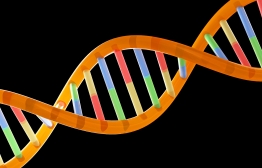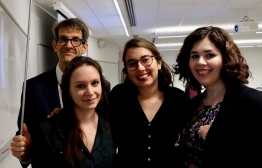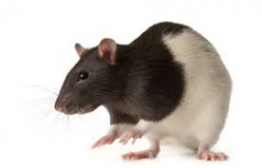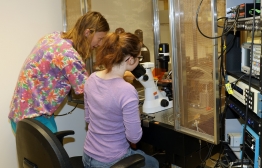As a Loyola student, you have the opportunity to work alongside our talented professors to partner in collaborative research. Learn more about some recent research and projects currently underway.
Senior Capstone Projects
All majors in French, Latin American Studies, and Spanish prepare a senior Capstone project which is normally presented during their last semester at Loyola. Projects vary greatly, from literary analysis, to concerts, to social research, or whatever makes sense with the student's background and interests. For some examples, click here.
Biochemistry
Dr. Walkenhorst is a physical biochemist whose research involves studying the structure, function, and stability of peptides and proteins in solution. He uses chemical, biological, and instrumental techniques to study several classes of proteins. His most recent project involves studying the effect of environmental factors such as pH, ionic strength, toxic ions, and surface type on the activity of a new class of membrane active antibiotics called antimicrobial peptides. He conducts research with undergraduate students interested in careers in biochemistry and medicine. Dr. Walkenhorst is a founding member of the New Orleans Protein Folding Intergroup (NOProFIG) which began in January 1999 and meets every two weeks to discuss research results of local researchers in related fields.
Dr. Walkenhorst's work has been published in journals such as Antimicrobial Agents and Chemotherapy, Biochemica Biophysica Acta: Biomembranes, Biochemistry, Journal of Molecular Biology, Protein Science, Journal of the American Chemical Society, Analytical Chemistry, and Protein Engineering.
For more information, contact William Walkenhorst, Ph.D., at walken@loyno.edu
Research in the Schoeffler Lab centers on exploring the sequence-structure-function paradigm as it relates to enzyme specialization. This means we're interested in understanding how changes at the genetic level lead to functional changes in proteins, optimizing them for particular jobs or particular environments. We study “interesting systems with hidden differences”: DNA modification enzymes that work at either near-boiling or near-freezing conditions, RNA modification enzymes that have the same shape but recognize dramatically different biochemical targets. In studying these systems, we ask: What small differences at the atomic level are driving these big differences in the macromolecule, and thus the organism? To interrogate these relationships, we use tools from computational biochemistry and bioinformatics, biochemistry, and structural biology. Our work is basic in nature but has implications for big problems like antibiotic resistance, bioengineering, and the search for extraterrestrial life.
Find out more about our work at the Schoeffler Lab website (Loyola login required):
https://sites.google.com/loyno.edu/schoefflerlab/home
Students interested in working in the lab should contact Dr. Schoeffler by email (ajschoef@loyno.edu). Some of our lab meetings are open-attendance; any interested Loyola student can ask for and receive an invitation to “sit in” and learn more about the lab by contacting Dr. Schoeffler.
Students and Faculty Work Together on Effective Altruism
Loyola undergraduates Melody Bigelow-Monssen, Emily Ortiz, and Kalya Koonz worked with philosophy professor Leonard Kahn on two effective altruism projects in the spring of 2019. The results was a panel discussion during the university's Earth Week celebration and a scholarly review of William MacAskill's Doing Good Better, co-written by Ortiz and Kahn, which was published in the journal Philosophy in Review.
Mental Health Risk and Resilience in Service Members Deployed to Combat Zones
Kate Yurgil, Assistant Professor of Psychology, pursues multidisciplinary research that integrates measures of human behavior, cognition, and neurophysiology. Her most recent work, to be funded through a Department of Defense Congressionally Directed Medical Research (CDMR) Program Neurosensory and Rehabilitation Research Award, focuses on tinnitus (i.e. ringing of the ears) and hearing loss in relation to blast injuries, which have been deemed the signature wounds of the recent wars in Iraq and Afghanistan. An estimated 12-23% of returning service members attest to a traumatic brain injury, and among those exposed to explosions, up to 77% sustain permanent hearing loss and 60-75% report tinnitus. Dr. Yurgil will collaborate with Dr. Dewleen Baker, Research Director at Veterans Affairs Center of Excellence for Stress and Mental Health in San Diego, CA and Professor of Psychiatry at University of California San Diego, the PI, who directs multiple research programs on post-traumatic stress disorder and traumatic brain injury. Drs. Yurgil and Baker, together with a team of physicians, scientists, and clinicians, integrate biological, physiological, psycho-social, and neuroimaging techniques to investigate predictors of mental health risk and resilience in service members deployed to combat zones.
Mental Health Risk and Resilience in Service Members Deployed to Combat Zones
Kate Yurgil, Assistant Professor of Psychology, pursues multidisciplinary research that integrates measures of human behavior, cognition, and neurophysiology. Her most recent work, to be funded through a Department of Defense Congressionally Directed Medical Research (CDMR) Program Neurosensory and Rehabilitation Research Award, focuses on tinnitus (i.e. ringing of the ears) and hearing loss in relation to blast injuries, which have been deemed the signature wounds of the recent wars in Iraq and Afghanistan. An estimated 12-23% of returning service members attest to a traumatic brain injury, and among those exposed to explosions, up to 77% sustain permanent hearing loss and 60-75% report tinnitus. Dr. Yurgil will collaborate with Dr. Dewleen Baker, Research Director at Veterans Affairs Center of Excellence for Stress and Mental Health in San Diego, CA and Professor of Psychiatry at University of California San Diego, the PI, who directs multiple research programs on post-traumatic stress disorder and traumatic brain injury. Drs. Yurgil and Baker, together with a team of physicians, scientists, and clinicians, integrate biological, physiological, psycho-social, and neuroimaging techniques to investigate predictors of mental health risk and resilience in service members deployed to combat zones.
Behavioral Neuroendocrinology Research
Dr. Grissom's research focuses on understanding sex differences in stress and anxiety across the lifespan, and how these differences impact learning and memory. Elevations in stress hormones at different critical developmental timepoints impact learning and memory in males and females differently. Increased anxiety resulting from stress exposure impacts learning style in a sex-specific manner as well. Dr. Grissom's current work uses rodent models to examine how elevations in stress hormones at different critical developmental periods impact measures of anxiety, and how this, in turn, alters learning and memory in males and females via changes in cell structure and function in related brain areas.
Behavioral Neuroendocrinology Research
Dr. Grissom's research focuses on understanding sex differences in stress and anxiety across the lifespan, and how these differences impact learning and memory. Elevations in stress hormones at different critical developmental timepoints impact learning and memory in males and females differently. Increased anxiety resulting from stress exposure impacts learning style in a sex-specific manner as well. Dr. Grissom's current work uses rodent models to examine how elevations in stress hormones at different critical developmental periods impact measures of anxiety, and how this, in turn, alters learning and memory in males and females via changes in cell structure and function in related brain areas.
Recent publications of English Faculty
Dr. Hillary Eklund:
https://edinburghuniversitypress.com/book-teaching-social-justice-throug...
Dr. Christopher Schaberg:
https://www.bloomsbury.com/us/searching-for-the-anthropocene-9781501351822/
Dr. Mark Yakich:
https://www.penguinrandomhouse.com/books/570064/spiritual-exercises-by-m...
Biophysics
All living cells in order to survive and to perform their physiological functions continuously exchange various atoms and molecules with the extracellular medium. Of particular importance are ions such as sodium, potassium, or calcium. Their controlled exchange with the extracellular medium is crucial to action potentials in neurons, muscle contraction, etc. Since the cellular membrane is normally impermeable to ions, their exchange is facilitated by special proteins called the ion channels, which are embedded in the membrane and form gated microscopic pores.
The focus of our research is to better understand the function of these proteins and their nonequilibrium properties. We know they can detect certain environmental factors, such as changes in electric field, presence of cer
tain ligands or even mechanical stress, and can open or close in response to these factors (ion channel gating). This way they can control and regulate various physiological processes. We use the experimental technique of patch-clamping and recent advances in mathematics and statistical physics to better characterize and control the process of channel gating. We also look at the interaction of inorganic nanoparticles, e.g. multiferroic nanoparticles, with biological cells.
Current Projects:
- Remote control of voltage-sensing biological macromolecules using multiferroic nanoparticles - with L. Malkinski (University of New Orleans)
- Conductance hysteresis in ion channels
- Experimental detection of nonequilibrium kinetic focusing in voltage-gated ion channels
- Optimization of wavelet-based voltage protocols for ion channel electrophysiology
- Quantum biology - modeling photosynthesizing complexes in plants - with L. Celardo (University of Puebla, MX)
Undergraduate Research:
Biophysics research combines experiments, computations, and theoretical analysis. Student researchers in the Biophysics lab can choose between doing experiments (preparing biological samples, performing patch-clamping experiments) and computational work (analysis of raw experimental data generated from patch-clamping experiments, simulation of ionic currents, and building models of channel gating kinetics). Our experiments use modern ion channel electrophysiology methods, such as the patch clamping technique. The lab is equipped with two patch-clamping stations, one of which is devoted to student training. Most of the numerical simulations are done using MATLAB.
Current student members of the lab:
- Ariel Hall (Physics'20)
- Cole Green (Physics'20)
- Megan Adamson (Physics'21)
- Kimiasadat Mirlohi (Physics'22)
Former lab members include:
- Kaough Baggett (Physics'18)
- Ilyes Benslimane (Physics'17)
- Antonio Ayala (Physics'17)
- Dustin Lindberg (Physics'14)
- Douglas Alexander (Physics'14)
- Michael Kammer (Physics'12)
- David Vumbaco (Physics'12)
- Warner Sevin (Physics'11)
- Stella von Meer (Physics'09)
- Meagan Relle (Biology'08)
Recent publications from the Lab:
- A. Kargol: "Introduction to Cellular Biophysics. Vol. II. From membrane transport to neural signaling". IOP Concise Physics, Morgan & Claypool Publishers 2019
- A. Kargol: "Introduction to Cellular Biophysics. Vol. I. Membrane transport mechanisms". IOP Concise Physics, Morgan & Claypool Publishers 2018
- A. Kargol, L. Malkinski, R. Eskandari, M. Carter, D. Livingston: “Cellular Defibrillation”: Interaction of Microscale Electric Field with Voltage Gated Ion Channels. J. Biol. Phys. (2015)
- A. Ayala, J.D. Alexander, A.U. Kargol, L. Malkinski, A. Kargol: Piezoelectric micro- and nanoparticles do not affect growth rates of mammalian cells in vitro. J. Bionanosci. 8 (2014) 309-312
- L. Ponzoni, G.L. Celardo, F. Borgonovi, L. Kaplan, A. Kargol: Focusing in Multiwell Potentials: Applications to Ion Channels. Phys. Rev. E 87 (2013) 852137
- A. Kargol: Wavelet-based protocols for ion channel electrophysiology. BMC Biophysics 6:3 (2013)
- A. Kargol, L. Malkinski, G. Caruntu: Biomedical applications of multiferroic particles. In: Advanced Magnetic Materials, InTech (2012)
- A. Kargol, M. Kargol: Passive transport processes in cellular membranes. In: Porous media: Applications in biological systems and biotechnology, Taylor and Francis Group, LLC (2011)
Social and Biological Influences on Primate Behavior and Reproduction
Dr. Evan Zucker, Professor of Psychology, studies the social and biological influences on the behavior and reproductive outcomes of nonhuman primates, as well as studying naturally-occurring patterns of human behavior (human ethology) and other aspects of social phenomena. His recent research has focused on the relationship between familial social status and life-history variables, as well as how indices of health in black howling monkeys are related to ecological factors, group composition factors, and reproductive status.







